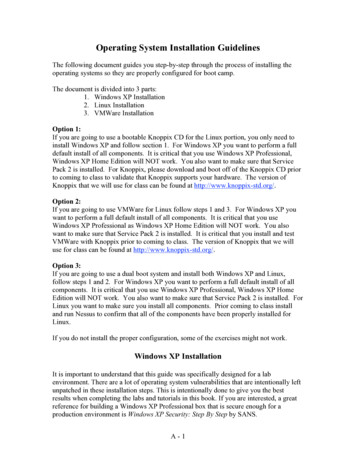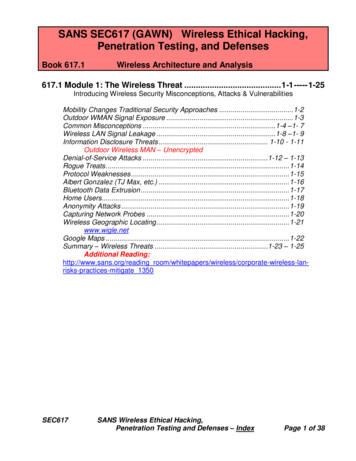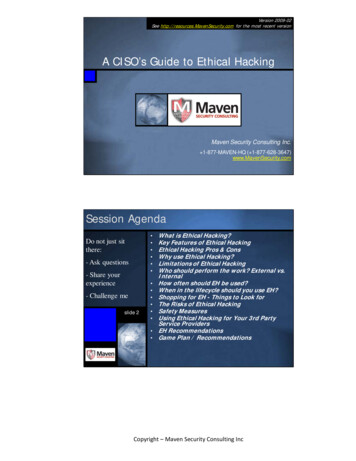
Transcription
Operating System Installation GuidelinesThe following document guides you step-by-step through the process of installing theoperating systems so they are properly configured for boot camp.The document is divided into 3 parts:1. Windows XP Installation2. Linux Installation3. VMWare InstallationOption 1:If you are going to use a bootable Knoppix CD for the Linux portion, you only need toinstall Windows XP and follow section 1. For Windows XP you want to perform a fulldefault install of all components. It is critical that you use Windows XP Professional,Windows XP Home Edition will NOT work. You also want to make sure that ServicePack 2 is installed. For Knoppix, please download and boot off of the Knoppix CD priorto coming to class to validate that Knoppix supports your hardware. The version ofKnoppix that we will use for class can be found at http://www.knoppix-std.org/.Option 2:If you are going to use VMWare for Linux follow steps 1 and 3. For Windows XP youwant to perform a full default install of all components. It is critical that you useWindows XP Professional as Windows XP Home Edition will NOT work. You alsowant to make sure that Service Pack 2 is installed. It is critical that you install and testVMWare with Knoppix prior to coming to class. The version of Knoppix that we willuse for class can be found at http://www.knoppix-std.org/.Option 3:If you are going to use a dual boot system and install both Windows XP and Linux,follow steps 1 and 2. For Windows XP you want to perform a full default install of allcomponents. It is critical that you use Windows XP Professional, Windows XP HomeEdition will NOT work. You also want to make sure that Service Pack 2 is installed. ForLinux you want to make sure you install all components. Prior coming to class installand run Nessus to confirm that all of the components have been properly installed forLinux.If you do not install the proper configuration, some of the exercises might not work.Windows XP InstallationIt is important to understand that this guide was specifically designed for a labenvironment. There are a lot of operating system vulnerabilities that are intentionally leftunpatched in these installation steps. This is intentionally done to give you the bestresults when completing the labs and tutorials in this book. If you are interested, a greatreference for building a Windows XP Professional box that is secure enough for aproduction environment is Windows XP Security: Step By Step by SANS.A-1
To create a properly configured laptop for the Security Essentials Boot Camp, follow thedetailed steps in this document—from the initial setup screen to the final login. Thisguide was designed for use on a system that doesn't already have a Windows platforminstalled on it. If your machine does not have a blank hard drive, some of the screens yousee at the beginning of the installation may be different from what you see in this chapter.If different screens appear, it is important that you always choose the option to replace,or overwrite. Do not choose to upgrade. The Windows install should also be placed in thedefault c:\windows directory.Creating Boot DisksIf your system does not support the capability to boot off of a CD-ROM, you can use theWindows XP boot disk to boot. If you do not have a set of the four disks, you need to usea machine that already has Windows XP Professional installed on it. The following stepsshow you how to create the four boot disks:1.2.3.4.5.6.7.Label four blank, formatted, 3.5-inch, 1.44-MB floppy disks as: SetupDisk One, Setup Disk Two, Setup Disk Three, and Setup Disk Four.Insert Setup Disk One into the floppy disk drive of a Windows or DOSsystem.Insert the Windows XP CD-ROM into the CD-ROM drive.Click Start, and then click Run.In the Open box, type D:\bootdisk\makeboot a: (where D: is the driveletter assigned to your CD-ROM drive), and then click OK.Follow the screen prompts.After you have completed the screen prompt requests, insert Setup DiskOne into the floppy disk drive of the lab PC and power the PC on.Booting from the CD-ROMA-2
If your system supports booting off of the CD-ROM, you do not need to use the diskspreviously discussed. Instead, follow these steps:1.Simply start by placing the Windows XP CD-ROM into your CD tray andpower on your machine. The first non-blank screen you should see is theone shown in the following illustration.A-3
2.If the previous screen does not appear, reboot your machine and open upthe BIOS. You need to make the system boot to the CD-ROM first. Thefollowing screen is one of several different BIOSes you could have onyour system. You need to navigate to a screen that allows you to changethe Boot Order. This is where you tell it to boot off of the CD-ROM.A-4
3.4.Now your system should boot off of the CD-ROM. After a period of time(typically 30-45 seconds), the following screen appears. Because we aredoing an initial install, you only need to press Enter to continue.Hit Enter at the next screen to continue installation.A-5
5.The Microsoft Windows XP Licensing Agreement appears next, as shownin the following screen. It is important that you read and understand thisagreement before continuing with the installation. After you have read andagreed to the contents of the license, press F8 to continue.Defining Drive PartitionsYou now need to define the drive partitions. Defining your drive partitions is used insteadof FDISK. When defining your drive partitions, it is extremely important that you leaveenough space for your Linux partition! Following are the steps:1.Press C to create a partition for your Windows install.2.You need a minimum of 2Gb of space for each of your operating systems.When you are prompted for the size of the partition, enter a number that isequal to 50 percent of your available hard drive space. Then, highlight thepartition, which should be labeled Unpartitioned space (see the followingillustration), and press C.Note: If partitions already exist they should be deleted. However you should realize thatthis will permanently remove any data that is currently on your system.A-6
Now create your new partition to be at least 2 Gb. In the provided space type 2047 andpress EnterA-7
You should now see two partitions. Verify that the new 2047 partition is highlighted andpress Enter.Formatting Drive PartitionsThe next step is to format your partition. For security reasons, you should format yourpartitions using NTFS. NTFS is a Windows partition type that allows you to assignpermissions at the folder level. This level of granularity is not the same for FATpartitions. NTFS also allows for lager partition sizes compared to the 2Gb limit thatcomes with FAT16. The steps for formatting your partition follow:A-8
1.Highlight the NTFS Quick partition option as shown in the followingscreen, and press Enter.2.After you press Enter, the system formats the partition, as shown in thefollowing screens. Depending on the size of the partition, this step cantake from 5 minutes to an hour. This is a great time to refill your caffeinelaced beverage of choice. (You may need it because you have a long wayto go.)A-9
Since this will take a while you should just wait while this process continues.When you return to your machine, you may see one of the following screens. Don't bealarmed. The system has completed the formatting process and has automaticallyrebooted. After this occurs, you have to answer the remaining install questions.A - 10
A - 11
Customizing Your SystemNow Windows presents a series of questions, which, when answered, customize yoursystem. The following steps walk you through the process of customizing your system:1.Typically, you only need to make changes during the next step (see thefollowing screen) if you are located outside of the United States or if youuse a non-standard keyboard. If you are in the United States and you areusing a standard QWERTY keyboard, press the Next button. If you arelocated outside of the United States, you should change your localesettings.A - 12
2.Enter your name and the organization you work for in the Name andOrganization fields. For the purposes of this course, have some funmaking up fictional names. Click the Next button when you are done.A - 13
3.In the next screen, enter the Product Key number that came with yoursoftware (find it on your CD). If you make a mistake when you enter thekey, you receive an Invalid Key message and the system gives youanother opportunity to enter it. Once you enter in the valid key, press theEnter key.A - 14
4.Now enter a name in the Computer name field to name your computer. Ifyou are part of a corporation’s domain, you need to follow yourcorporation’s guidelines for naming systems. For our purposes, name yourmachine whatever you desire. Then, type in a password in theAdministrator password field. You also need to confirm the password,as shown in the following screen. Then, click the Next button.Warning: A common mistake many administrators make at this stage is toleave the Administrator password field blank. It is highly advisable thatyou enter a password that matches your company’s password policy forlocal passwords. You don't want to forget to change the password afteryou have completed the installation. Also, make sure you remember thispassword. You will need it to login.A - 15
Note: Depending on your configuration, you might receive the Modem DialingInformation Screen. Just cancel out of this or click Next to get to the nextscreen.5.In the screen that appears, enter the current time, and then fill in the Datefield and Time Zone field. Click Next.A - 16
6.After you make the previous configurations, the system installs yournetworking components, as shown in the following screen.A - 17
Customizing Network SettingsNow you need to set up your system so that it can be networked with other systems.Following are the steps:1.First, you must choose the type of settings you are going to use. Note thatit is rarely a good idea to use Typical settings when configuring anapplication or operating system. It is always a good idea to chooseCustom settings, as shown in the following screen. When you use thisoption, you only install options you need. You won't end up installingsomething you aren't aware of because you chose an option thatautomatically does this. After you select the Custom settings option, clickNext.A - 18
2.Windows no longer tries to install IPX/SPX, so there is nothing in thecustom settings that you need to remove. This is a great time to setup yourlocal IP address if you are not using a DHCP server in your environment.The assumption here is that you are not going to plug this test machineinto a production environment, so it's safe to add your own IP address.Highlight Internet Protocol (TCP/IP) and click the Properties tab.A - 19
3.The following screen appears, which allows you to enter your own IPaddress. For the purposes of this exercise, use a non-routable IP address.Select ‘Use the following IP address’. Enter 192.168.1.2 in the correctfields. Then, enter a standard 24-bit subnet mask of 255.255.255.0. Tomake the entire section complete, enter a default gateway setting of192.168.1.1. Enter the appropriate DNS server IP addresses for yourenvironment into the fields shown in the following paragraph. You canleave your DNS sever fields blank for this system. Click OK. Click Next.A - 20
4.As previously stated, you are not joining a network or a domain, so justenter a name of your choice and leave the first No option enabled (see theillustration that follows). After you have the information entered, clickNext.A - 21
5.Windows completes the networking portion of the installation and moveson to its final tasks. This step takes a long time, so take the opportunity tograb another caffeine-laced beverage.A - 22
6.If you get the following screen, shout for joy. Congratulations, you havesuccessfully installed Windows XP. Click Finish, and then remove theWindows CD-ROM before the system reboots so that you don’taccidentally start the install process again. If you accidentally leave theCD-ROM in, and the install process starts again, simply remove the CDROM and hard-boot the machine (restart it).A - 23
9.After the next screen comes up, click the OK button.A - 24
10. As shown in the next screen, you now need to log in using the Administratoraccount and the password you entered earlier during the install. After youhave entered the appropriate credentials, click OK.Note: Depending on your version of the software you might get several screensabout connecting to the Internet and registering Microsoft before you get the loginscreen.Note: At this stage, the base installation of Windows XP is installed. The instructions thatfollow show you how to upgrade to Service Pack 2, which is recommended for this class.Installing Service Pack 2If you do not have SP2 on a CD, you need to get Internet access setup, so that you canpatch this box to SP2. SP2 provides several functional patches, which is why you want toupgrade to it.The first thing you need to do is verify that your NIC (Network Interface Card) isworking and that you have connectivity. Ensure that your system has the NIC pluggedinto a switch or hub that is connected to the Internet. If you have a DHCP (Dynamic HostConfiguration Protocol) server on your network, you should be able to automatically pullA - 25
an IP address. Otherwise, you need to statically assign the appropriate IP address for yoursystem.Note: You will need to change the address scheme you entered earlier if you need toconnect to the Internet to download SP2.Following are the steps for upgrading to SP2:1.Left click on the Start button located in the lower left portion of yourscreen. Then highlight and left click Control Panel.A - 26
2.Now click on Network and Internet Connections. The following screenshould appear. Left click on Network Connections.A - 27
3.The following screen should appear. If you do not see a Local AreaConnection, you do not have a NIC (Network Interface Card) installed orproperly working. If this is the case you will need to check with your NICvendor’s documentation on getting your particular card installed inWindows XP. Most modern NICs are fully compatible with WindowsXP.A - 28
4.Right click on Local Area Connection and then left click on Propertiesin the menu that appears. This screen shows you the differentconfiguration items that this particular interface uses. To exit this, clickon OK.A - 29
5.After the Hardware Manager is properly setup, you need to validate that the IPaddress we initially configured is on your system. Click on Start, Run, and thentype cmd. Type ipconfig. If you see an IP address next to the NIC, you canproceed.If you do not see an IP address, or you see the address with 169.254.30.x, youdidn't pull an IP address from your DHCP server or the IP configuration step wepreformed earlier was not successful. You will need to manually add an IPaddress by repeating the steps described during the installation of Windows XP. Ifyou need to repeat these steps to add an appropriate IP address for your network,do so now.A - 30
6.Next, you need to verify connectivity to the Internet. To make sure yourlocal IP stack is functioning correctly, you can PING the loopbackadapter. To do this, open another command window by selecting Start,Run, and then type cmd. Then, type ping 127.0.0.1, as shown in thefollowing screen.A - 31
7.As you can see, there is connectivity to the local IP stack. This shows thatthe TCP/IP stack is functioning correctly. To verify Internet connectivityand that the DNS settings are working correctly, ping a web site. The IPaddress used in the following screen is not valid. You need to ping a validIP address. For example, pinging www.sans.org should work.Note: If you are not on a network that is connected to the Internet thisstep will not work. Also, if you are properly connected to an Internetaccessible network and you used the IP address we supplied, and it doesnot match the network information of your network, this step will notwork. If the later is the case, please change your IP address to match theinformation that is appropriate for your environment.8.If you get an Unable to resolve name message, you need to validate thatyou have entered your DNS servers into the TCP/IP properties of yourNIC correctly.A - 32
9.To get your browser functioning, double-click the Internet Explorer iconon your desktop and follow the wizard's instructions. In the first windowclick on Cancel since we will not be using a modem.A - 33
10.In the next window choose the appropriate option for your homeenvironment. If you are part of a LAN (Local Area Network), choose thefirst option (Connect to the Internet). Then, click Next.A - 34
11.In the next screen, choose Set up my connection manually. Click Next.A - 35
12.Do not change any options for the next screen. Leave it alone, and simplyclick Next.A - 36
13.You have now setup Internet Explorer for web surfing, so click Finish.You can now go to Microsoft’s web site to download and install ServicePack 2.A - 37
14.The last thing we need to do prior to installing anything on our system,including the Service Pack, is to create a folder that we will be storing allof the installation executables throughout this book.Click on Start then My Computer. Double click on C. Now right clickanywhere in the window and left click New then Folder. Name the newfolder tools as shown belowA - 38
15.To install Service pack 2, go to the following .mspxThe Microsoft web site is shown in the following screen.16.Ensure that English is the Selected Language and click Go.A - 39
17.You can now select either Express or Network Installations. Bothoptions work, but you should choose the Network Installation option.Next, you should download Service Pack 2 into the tools directory youcreated earlier or a different directory that you create.18.After the download is completed, double-click the SP2 executable andfollow the given prompts for installation.19.Read the License Agreement carefully. When you understand and agreewith it, click on the button next to I Agree then click Next.20.Because you do not need to uninstall this Service Pack, you can check theDo Not Archive Files option.21.Now you get to wait and watch. It is important to note that this process cantake an extremely long time, even if it seems your system has locked up, itmost likely has not. After the Service Pack is completely installed, rebootyour machine and you are ready to move on to the next section.You have now successfully completed the installation of Windows XP.A - 40
Linux InstallationNow you are going to install Red Hat 9.0. The first step is to insert the Red Hat 9.0 Disc1 into your CD-ROM drive. Next, power on the system. The system boots off of the CDROM and begins the Red Hat installation program. Follow these steps to complete theinstallation of Red Hat:1.When the Red Hat Installation screen appears (the first screen) typelinux text at the boot: prompt and press Enter, as shown in the followingscreen.A - 41
2.Press the Tab key until Skip is highlighted, and then press Enter.3.The “Welcome’ screen appears. Press Enter.A - 42
4.The ‘Language Selection’ screen appears. Ensure that the language is setto English. Press the Tab key until OK is highlighted, and then pressEnter.A - 43
5.The ‘Keyboard Selection’ screen appears. Accept the default keyboard us.Press the Tab key until OK is highlighted and press Enter.A - 44
6.The ‘Mouse Selection’ screen appears. Press the Tab key until the boxnext to Emulate 3 Buttons is selected and press Space Bar to place anasterisk in the brackets [*]. Next, press the Tab key until OK ishighlighted and then press Enter.A - 45
7.The ‘Installation Type’ screen appears. Use the arrow keys to highlightCustom. Press the Tab key until OK is highlighted and then press Enter.A - 46
8.The ‘Disk Partitioning Setup’ screen appears. Press the Tab key untilDisk Druid is highlighted, and then press Enter.Note that the values used to partition the hard drive may need to be altered basedon the memory and hard drive size of the system that you are using.A - 47
9.The ‘Partitioning’ screen appears. Press the Tab key until New ishighlighted, and the press Enter.A - 48
10.The ‘Add Partition’ screen appears. In Mount Point: type /. Press the Tabkey until the cursor is in the Size (MB): field. Enter 5800. Press the Tabkey until OK is highlighted, and then press Enter.A - 49
11.The ‘Partitioning’ screen reappears. With the arrow and Tab keys,highlight Free Space, as shown in the following screen. Afterwards, pressthe Tab key until New is highlighted, and then press Enter.A - 50
12.The ‘Add Partition’ screen appears. Press the Tab key once to select theFile System type: field. Using the arrow keys, highlight swap. Press theTab key until the Size (MB): field is selected. Enter 256. Press the Tabkey until OK is highlighted, and then press Enter. These fields andselections are shown in the following screen.A - 51
13.The ‘Partitioning’ screen reappears. Press the Tab key until OK ishighlighted. Press Enter.A - 52
14.The ‘Boot Loader Configuration’ screen appears. Press the Tab key untilOK is highlighted, and then press Enter.A - 53
15.The ‘Boot Loader Configuration’ screen appears. Press the Tab key untilOK is highlighted, and then press Enter.A - 54
16.The ‘Boot Loader Configuration’ screen appears. Press the Tab key untilOK is highlighted, and then press Enter.A - 55
17.The ‘Boot Loader Configuration’ screen appears. Use the Tab and arrowkeys to highlight DOS and then press the Tab key until Edit ishighlighted, and then press Enter.A - 56
18.The ‘Edit Boot Label’ screen appears. Change the Boot Label field toWindows XP. Press the Tab key until OK is highlighted and pressEnter.A - 57
19.The ‘Boot Loader Configuration’ screen appears. Press the Tab key untilOK is highlighted and press Enter.A - 58
20.The ‘Boot Loader Configuration’ screen appears. Press the Tab key untilOK is highlighted and press Enter.A - 59
21.The ‘Network Configuration for eth0’ screen appears. Press the Spacebarto remove the * (asterisk) in the following [ ] Use bootp/dhcp option.Press the Tab key to select the IP address field.Enter the following parameters: IP address:Netmask:Default gateway (IP):Primary .168.1.4After you enter the parameters, press the Tab key until OK is highlighted,and then press Enter.A - 60
22.The ‘Hostname Configuration’ screen appears. Enter linux-lab in theHostname field. Press the Tab key until OK is highlighted, and then pressEnter.A - 61
23.The ‘Firewall Configuration’ screen appears. Press the Tab key until ( )No Firewall is selected. Press the Spacebar to insert an asterisk (*), asshown in the screen. Then, press the Tab key until OK is highlighted andpress Enter.A - 62
24.The ‘Language Support’ screen appears. Press the Tab key until OK ishighlighted, and then press Enter.A - 63
25.The ‘Time Zone Selection’ screen appears. Press the Tab key until OK ishighlighted, and then press Enter. (If you are in a different time zone, usethe Tab and arrow keys to select the appropriate time zone.)A - 64
26.The ‘Root Password’ screen appears. In the Password: field, type astrong password to use for the root account. Confirm the password bytyping it in the Password (confirm): field. Press Tab until OK ishighlighted and press Enter.A - 65
27.The ‘Authentication Configuration’ screen appears. Press the Tab keyuntil OK is highlighted, and then press Enter.A - 66
28.The ‘Package Group Selection’ screen appears. Press End to highlightEverything and then press Space Bar to select it. (an asterisk identifiesthe option as selected) Press the Tab key until OK is highlighted andpress Enter.A - 67
29.The ‘Installation to begin’ screen appears. Press Enter.A - 68
30.The ‘Formatting’ screen appears. The Formatting / file system message appears. Proceed to the next step.A - 69
31.The ‘Copying File’ screen appears. The Transferring install image tohard drive message appears. Proceed to the next step.A - 70
32.The ‘Package Installation’ screen appears. Red Hat now starts installingthe packages. Proceed to the next step.A - 71
33.The ‘Change CDROM’ screen appears. When prompted, insert the RedHat Disc 2 and press Enter.A - 72
34.The ‘Change CDROM’ screen appears again. When prompted, insert RedHat Disc 3 and press Enter.A - 73
35.The ‘Post Install’ screen appears. After all of packages have beeninstalled, Red Hat performs the post-install configuration, as shown in thefollowing screen. Proceed to the next step.A - 74
36.The ‘Boot Diskette’ screen appears. Press Enter to create a boot disk.A - 75
37.The ‘Insert a floppy disk’ screen appears. Insert a blank diskette into yourfloppy drive. Press TAB to highlight Make boot disk and press Enter.A - 76
38.The ‘Video Card Configuration’ screen appears. Use the Tab key andEnter key to select the appropriate video card settings for your system.Press the Tab key until OK is highlighted, and then press Enter.A - 77
39.The ‘Monitor Configuration’ screen appears. Again, use the Tab andEnter keys to select the appropriate monitor settings for your system.Press the Tab key until OK is highlighted, and then press Enter.A - 78
40.The ‘X Customization’ screen appears. Press the Tab key until ( ) Text isselected, and then press the Spacebar. Press the Tab key until OK ishighlighted, and then press Enter.A - 79
41.The ‘Complete’ screen appears. Congratulations, you have just installedRed Hat Linux. After removing the boot disk created earlier in theinstallation, press Enter to reboot the system. The CD-ROM will ejectduring the reboot process.A - 80
42.As the system is rebooting you will be presented with the choice ofbooting into Red Hat or Windows XP. Use the arrow keys to select theOS that you want to boot into and press Enter to boot the choice. Notethat the GRUB boot loader is only presented for a few seconds before thedefault OS is booted so you have to be paying attention.A - 81
VMWare InstallationThis section will walk you through the process of installing VMWare and configuring itto work with Knoppix.1) Install VMWare (These instructions are tested with VMWare 5.0)a. Double click on *.exeb. Follow instructions until VMWare install completesc. Enter the appropriate software licensed. Reboot if asked2) Download the Knoppix ISO image file and burn to CDhttp://www.knoppix-std.org/3) Pre-requisites to running VMWare: (it can operate with less but for optimalperformance, the following are recommended)a. Pentium 4, 2GHz and aboveb. At least 1Gig of RAM4) Start VMWare (see screen below), Click on the circled icon “New VirtualMachine”A - 82
5) Click on “Next” (There are many tunable custom settings but for now just use theDEFAULT ‘typical’ settings)6) Select ‘Linux’ radio button, Select the ‘Other Linux 2.6.x kernel’ in the versionpull down, and click on “Next”A - 83
7) Name the Virtual Machine and select a location for the virtual machine. Select alocation with a lot of free space. The recommended drive’s free space should beat least 10 GigaBytes. When click on the ‘browse’ button to select a location, youcan also create directories if one does not exist. Finally select ‘next’8) Use the default ‘Bridged networking’ and click on ‘next’A - 84
9) Use the default disk size of ‘4.0 G’ and click on ‘finish’10) Knoppix Virtual Machine is now ready for use. Before power on the virtualmachine one final configuration is requiredA - 85
11) Before power on the virtual machine can be powered on, one final configurationis required to make sure that the virtual machine catches the CDROM. Normallythe ‘auto detect’ should work but to be sure that the virtual machine binds withthe appropriate drive (especially with multi-drive machines), we are going toforce a binding to a specified drive.After clicking on the above circled icon the following screen will popped up. Click on theCDROM Device, then select the appropriate drive and click on OKA - 86
12) Now the Virtual machine is ready to be powered on to configure the BIOS toboot the CDROM. Click on the green play icon. Note that as soon as the VirtualPC BOOTS the key F2 is needed to be pressed right away to enter BIOSconfiguration.13) Press F2 key at the following screen: (Enter BIOS configuration to boot from CD)A - 87
14) Note the mouse will not work now, so all inputs are from the keyboard (justlike when the PC boots). NOTE: to release the VM control of the keyboard, pressALT-CTRL at the same time.-Press the right arrow key until the boot tab is highlightedPress the arrow key until the CD-ROM drive is highlightedPress the button until the CD-ROM drive is at the top of the list(as shown)A - 88
15) Press the right arrow key to highlight the EXIT tabSelect the item ‘Exit Saving Changes’ (Make sure the Knoppix CD is insertedbefore hitting Enter)You should see a series of Knoppix boot screen and finally the X-Windowsscreen.A - 89
The Windows install should also be placed in the default c:\windows directory. Creating Boot Disks If your system does not support the capability to boot off of a CD-ROM, you can use the Windows XP boot disk to boot. If you do not have a set of the four disks, you need to use a machine that already has










